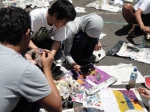Classroom Interaction in the New Normal Era Generates New Culture
By Adi Permana
Editor Adi Permana

BANDUNG, itb.ac.id–The Literacy, Media, and Culture Research Group of the Faculty of Arts and Design (FSRD) ITB hosted a webinar titled "Classroom Interaction in the New Normal Era: Cultural Perspectives and Semiotics” on Tuesday (3/8/2021). They invited numerous experts to speak at the event.
Dr. Lina Meilinawati Rahayu, M.Hum., Vice Dean of the Faculty of Cultural Sciences (FIB) Universitas Padjadjaran (Unpad) was present as the first speaker. As a speaker, Dr. Raden Safrina, M.A., Head of the Language Center of Universitas Pendidikan Indonesia also attended the webinar. While the next speaker was Dr. Acep Iwan Saidi, M. Hum. from Design and Visual Culture Research Group FSRD ITB.
Dr. Lina Meilinawati explains the portrait of a classroom in an Indonesian film in the first session. "Classroom pictures based on themes can be split into two categories: education and non-education subjects," she explained.
In terms of non-educational topics, a few Indonesian films feature an educator in a classroom who is terrifying yet is mocked by the students. This description has remained constant over time.
Poverty is frequently depicted in films about education. More specifically, the difficulty of someone from a less fortunate background, particularly in reaching a certain degree of education. This just goes to show how crucial education is for the audience's advancement.
The webinar was later followed by Dr. Raden Safrina's second presentation on the new educational norms. She noted that the pandemic shifted education into a different space, despite the fact that the components remained the same. As a result, a new class culture emerged, necessitating the adaptation of all parties involved.
Online learning, she argued, keeps kids away from social connection. “Unfortunately, most kids' primary motive for using technology in studying is to obtain affection. This is why online learning cannot be regarded as 'negating humanity’," she said.
The delivery of the material is also dependent on the students' participation in learning. This is why teachers must come up with creative strategies to win over their students' hearts. Attempting to brighten students' expressions as much as possible.
Dr. Acep Saidi, the final speaker, then discussed virtual learning rooms from a semiotic standpoint. A virtual learning room, according to him, is a learning ecosystem that exists in a virtual place. The consequence is that those engaging in virtual learning spaces must have a thorough awareness of virtual culture.
"This pandemic condition forces us to adopt virtual culture in order to advance technical breakthroughs. Do not memorize what you read, but rather comprehend the subject completely "Acep stated.
Creating a space imagination in which students participate as the primary characters and the teacher acts as the narrator. Making learning real in a virtual setting is similar to framing in a film.
Reporter: Zahra Annisa Fitri (Urban and Regional Planning, 2019)
Translator: Sekar Dianwidi Bisowarno (Bioengineering, 2019)

.jpg)
.jpg)
.jpg)
.jpg)
.jpg)



